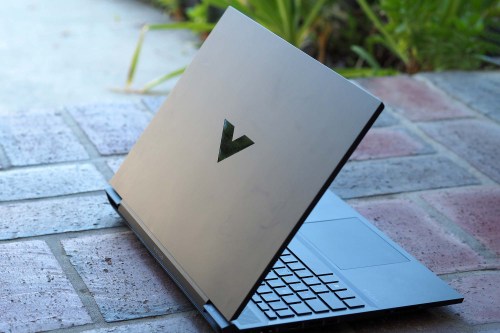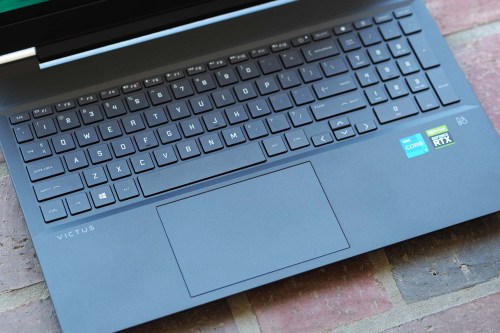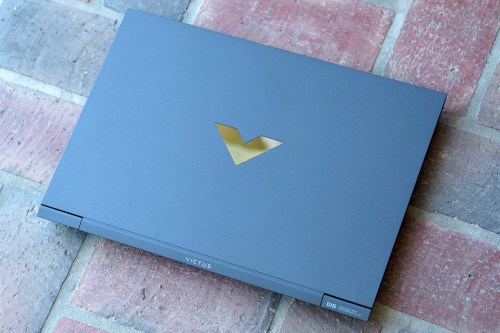HP Victus 16 2023 Review: Price & Gaming Features

The new Victus 16 is HP’s latest budget gaming laptop, ready to go toe-to-toe with the more affordable options in Acer’s Nitro and Asus’s TUF entry-level lines. So far, the Victus range hasn’t been quite as successful as those models, failing to the essentials you need for a great gaming experience at an affordable price point.
However, there’s an opportunity for the new model to turn that around, thanks to AMD’s Ryzen 5 7640HS CPU and the Nvidia GeForce RTX 4050 graphics processor. The latter struggles on high-resolution displays but can work perfectly for 1080p gaming, with enough grunt to run modern titles at medium to high detail settings, and DLSS 3 support for when you need a little extra help.
That said, this is an increasingly competitive market, and the HP Victus 16 isn’t the only gaming laptop with this kind of spec, with new models from Acer, Asus and Lenovo combining the RTX 4050 with beefy AMD or Intel CPUs. When you’re up against the likes of the recent Acer Nitro 5 and Nitro 16, you need something extra to stand out.
- Budget gaming graphicsThe RTX 4050 is the new go-to budget laptop offering 1080p performance plus a DLSS 3 frame rate boost.
- Powerful processorAMD’s mid-range mobile CPU has multi-threaded power for gaming, creative apps and more.
- Gaming-focused display16.1-inch 144Hz 1080p display offers balanced spec with a higher refresh rate for competitive gaming.
PROS
- Speedy Core i7 CPU
- Long battery life
- Decent connectivity including Ethernet and a 1080p webcam
- Reasonably trim for a 16-inch machine
CONS
- GeForce RTX 4050 lands awkwardly for this price
- A 60Hz display in 2023
- Review configuration lacks value
HP VICTUS 16 (2023) SPECS
| Laptop Class | Gaming |
| Processor | Intel Core i7-13700H |
| RAM (as Tested) | 16 GB |
| Boot Drive Type | Hard Drive |
| Boot Drive Capacity (as Tested) | 1 TB |
| Screen Size | 16.1 inches |
| Native Display Resolution | 1920 by 1080 |
| Touch Screen | |
| Panel Technology | IPS |
| Variable Refresh Support | None |
| Screen Refresh Rate | 60 Hz |
| Graphics Processor | Nvidia GeForce RTX 4050 Laptop GPU |
| Graphics Memory | 6 GB |
| Wireless Networking | 802.11ax (Wi-Fi 6) |
| Dimensions (HWD) | 0.94 by 14.53 by 10.21 inches |
| Weight | 5.15 lbs |
| Operating System | Windows 11 |
| Tested Battery Life (Hours:Minutes) | 10:08 |
The 2023 HP Victus 16 (starts at $1,099.99; $1,449.99 as tested) is available in multiple configurations, some of which strike as better values than the model we reviewed, which teams a 13th Generation Intel Core i7 processor with Nvidia GeForce RTX 4050 graphics and 1TB of storage. We have no complaints about this gaming laptop’s relatively plain physical design, and its battery is long-lasting, but a ho-hum display that tops out at a 60Hz refresh rate is a big miss for a gaming rig at this price. The 2023 HP Victus 16 neither separates itself from the lower end nor keeps pace with slightly more costly alternatives. This leaves the Gigabyte Aorus 15 BMF as our best budget gaming laptop still, and the MSI Katana 15 as a better deal overall compared with the Victus as configured.
Design

The first thing you might notice if you’re familiar with the Omen line is the Victus logo. It’s a “V” based on the same core geometry as the Omen logo, with the bottom portion essentially isolated to stand on its own. The logo’s not only on the outside lid and on the display chin, but it’s also embedded in the venting above the keyboard and outlines the venting on the chassis bottom. If nothing else, the Victus has its branding down.
The rest of the Victus 16’s aesthetic is minimalist, with few nods to a more flashy gaming design. The only real gaming design element is the row of vents along the back of the chassis. They lend some visual flair while also providing enhanced thermals (more on that in a bit). My review unit was in the Mica Silver (black) colour; Performance Blue and Ceramic White are the other options.
Overall, the Victus 16 is a gaming laptop with a more traditional laptop design. We’ve seen that with a few other gaming machines, such as the conservatively designed (and much more expensive) Razer Blade 15 and the Asus ROG Zephyrus G14, which, other than its lid and rear venting, also sports a nongaming aesthetic. The Lenovo Legion 5 Pro lives in both worlds at once, with a businesslike design with some gaming elements like aggressive vents seemingly pasted on. Conversely, the Asus ROG Strix G15 and the Alienware laptops maintain a die-hard gaming aesthetic through and through.
Battery and Display Tests
We test laptop battery life by playing a locally stored 720p video file with display brightness at 50% and audio volume at 100% until the system quits. We make sure the battery is fully charged before the test, with Wi-Fi and keyboard backlighting turned off.
Additionally, we use a Datacolor SpyderX Elite monitor calibration sensor and its Windows software to measure a laptop screen’s colour saturation—what percentage of the sRGB, Adobe RGB, and DCI-P3 colour gamuts or palettes the panel can show—and its 50% and peak brightness in nits (candelas per square meter).
Battery life is one of HP’s highlights, having lasted longer than any competitor here. That supports everyday use outside of the house, encouraging you to take this mostly portable laptop around as needed without keeping an eye out for the nearest AC outlet as you must with some gaming rigs. Its screen colour coverage and brightness were pretty pedestrians, though hardly an outlier in this mostly budget-priced group.
Performance
The Victus 16 is equipped with a 45-watt, eight-core/16-thread Intel Core i7-11800H — a workhorse among Intel’s lineup that provides some of the best creative application performance you’ll find outside of AMD’s Ryzen 5000 series. That’s not to mention its productivity performance, which is overkill for even demanding office workers.

The Victus 16 is undoubtedly a fast laptop even compared to comparably equipped mainstream laptops. It led the pack in Geekbench 5 with impressively high scores, tied for third place in Cinebench R23 (with the Lenovo Legion 5 Pro and its Ryzen 7 5800H being the fastest machine), took first place in our Handbrake test that encodes a 420MB video as H.265 and even achieved the high score in PCMark 10, a primarily productivity-oriented benchmark.
If you’re looking for a fast laptop for productivity and creative tasks, then you can’t go wrong with the HP Victus 16. It pushes its components to the extreme, thanks mainly to its excellent thermal design, and it’s certainly faster than your typical mainstream — and often thin and light — laptop. Note that you can also purchase the Victus 16 with an AMD Ryzen 7 4800H if you’d like even faster CPU performance.
| Laptop | Geekbench 5 | Cinebench R23 | PugetBench (Premiere Pro) |
Handbrake (seconds) |
PCMark 10 |
| HP Victus 16 (Core i7-11800H) | 1594 / 9141 | 1510 / 10145 | 765 | 91 | 6808 |
| Lenovo ThinkPad X1 Extreme Gen 4 (Core i7-11800H) | 1520 / 7353 | 1519 / 10497 | 388 | 99 | 6251 |
| Dell XPS 15 OLED 2021 (Core i7-11800H) | 1544 / 7692 | 1513 / 9979 | 509 | 101 | 6024 |
| MSI Creator Z16 (Core i7-11800H) | 1540 / 7625 | 1444 / 9615 | 738 | 103 | 6486 |
| Dell XPS 17 (Core i7-11800H) | 1568 / 8801 | 1525 / 10145 | 692 | n/a | 6209 |
| LG Gram 16 (Core i7-1165G7) | 1573 / 5454 | 1394 / 4137 | N/A | 213 | 4827 |
| Lenovo Legion 5 Pro (Ryzen 7 5800H) | 1460 / 7227 | 1430 / 11195 | 622 | 99 | n/a |
Keyboard and touchpad

Here’s one thing the Victus 16 did not inherit from the Omen line: Per-key RGB lighting on the keyboard. Although the Victus 16’s keyboard is indeed backlit with white lighting, it’s only on or off with no levels in between. So, HP has very carefully ensured that the Omen retains its advantage here. The keyboard feels great, though, with deep travel and very snappy switches that provide excellent responsiveness for both gamers and productivity users. It’s not a mechanical keyboard, but it shouldn’t hold back competitive gamers.
The touchpad is increased in size over the Pavilion Gaming 16, and it takes up most of the available space on the palm rest. It has a comfortable surface for swiping, but I found the buttons a little loose, and they vibrated just a touch when pressed. It’s nothing egregious, and as a Microsoft Precision touchpad, it supports the full complement of Windows 11 multitouch gestures. Overall, I’d rate the touchpad as competent but nothing to write home about.
There’s no Windows 11 Hello password-less support, and the display isn’t touch-enabled. So, those are two missing features that would have been welcome but are commonly missing in midrange gaming laptops.
Configurations
While our $1,360 review configuration was at the high end — with the Core i7-11800H, RTX 3060, 16GB of RAM, a 512GB SSD, and the 144Hz Full HD display — you can get the Victus 16 for much less money. For example, for just $730, you can get a Core i5-11400H, GTX 1650, 8GB of RAM, a 256GB SSD, and the entry-level 60Hz Full HD panel. But this, quite frankly, isn’t a configuration that most people are going to enjoy between the outdated graphics card and the 60Hz screen.
The most you can spend is $1,640 by upgrading our configuration to 32GB of RAM, a 1TB SSD, and a QHD (2,560 x 1,440) 165Hz display.
Gaming

But of course, the Victus 16 is a gaming laptop, and so it should be measured against other gaming laptops. Here, it also impressed, performing quite well given that it has one of the slower GPUs in our comparison group. Note that HP includes its Omen Gaming Hub app with the Victus 16, which enables undervolting and three power modes: Quiet, default, and performance.
I ran all the benchmarks — including those in the section above — in both default and performance modes and saw very little difference in performance. In most games, performance mode squeezed out only a few extra frame rates.
Its 3DMark Time Spy score was in line with our comparison group, coming in next-to-last place, with only the MSI Creator Z16 — a nongaming machine with the same GPU that I added for comparison purposes — posting a lower score.
| Laptop | 3DMark Time Spy | Assassin’s Creed Valhalla (1080p Ultra High) |
Battlefield V (1080p Ultra) |
Fortnite (1080p Epic) |
Civilization VI (1080p Ultra) |
| HP Victus 16 (RTX 3060) | 7341 | 59 fps | 72 fps | 99 fps | 118 fps |
| Razer Blade 14 (RTX 3070) | 8605 | 60 fps | 96 fps | 96 fps | 111 fps |
| Lenovo Legion 5 Pro (RTX 3070) | 9175 | 61 fps | 73 fps | 101 fps | 114 fps |
| Asus ROG Strix G15 (RX 6800M) | 10504 | 77 fps | 109 fps | 108 fps | 150 fps |
| MSI GS66 Stealth (RTX 3080) | 9097 | 70 fps | 117 fps | 140 fps | 149 fps |
| Razer Blade 15 (RTX 2080 Super) | 7637 | 58 fps | 98 fps | 110 fps | 134 fps |
| MSI Creator Z16 (RTX 3060) | 6322 | 50 fps | 57 fps | 56 fps (1600p) | 92 fps |
The Victus 16 moves a lot of air when it’s working hard, and so fan noise was quite audble. It’s not enough to force you to wear headphones at all times, but you might choose to do so nonetheless. The surface of the laptop remained reasonable, hitting 101 degrees Fahrenheit on the right side of the keyboard deck during benchmarking. The bottom of the chassis didn’t exceed 115 degrees F during my testing. During nongaming use, the laptop remained cool and quiet.



